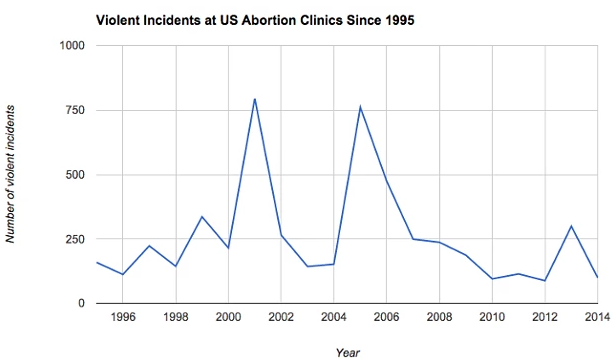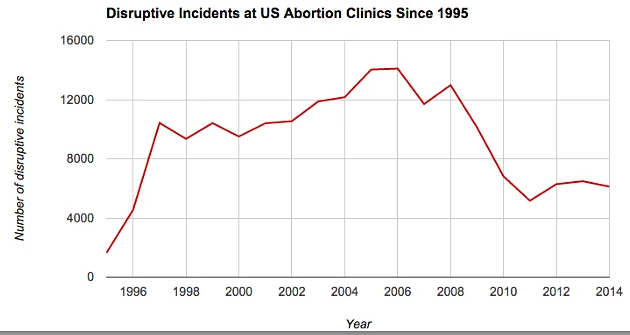The Troubling History of Violence at Reproductive Health Clinics
By:
A day after Thanksgiving, a 57-year-old man named Robert Lewis Dear opened fire at a Planned Parenthood in Colorado Springs, Colorado, killing three people and injuring nine others. The attack was shocking, but for some, like author and former Planned Parenthood worker Bryn Greenwood, terrorism at the clinic was nothing new.
"We received hundreds of phone calls, threatening to torch our clinic & to kill the 'murdering whores' who worked there," Greenwood wrote on Twitter in a string of posts Sunday recounting the violence directed at her, her coworkers, and a Wichita, Kansas Planned Parenthood facility where she worked.
Her branch, she noted, didn't even provide abortion services.
related: there's a pattern of terrifying attacks in the u.s. much scarier than isis
The weekend's deadly attack in Colorado—and responses like Greenwood's—shed light on a robust and consistent outcropping of homegrown American terror in recent years directed at reproductive health facilities like Planned Parenthood and their workers and patients.
Though protests and violent threats have become the norm in the landscape of America's abortion clinics, it's not often that they end in deaths: the last time a clinic attack turned deadly was in 1998, when Eric Robert Rudolph killed one off-duty police officer and severely injured a nurse at a clinic bombing in Alabama. Still, Dear's shooting could mark the ninth murder by anti-abortion activists since 1977, according to National Abortion Federation (NAF) numbers.
So far, the only indication that the shooting was motivated by anti-abortion sentiments was a statement made by Dear in an interview after the incident. "No more baby parts," he reportedly said, in what many have speculated was a reference to a series of heavily edited undercover videos of Planned Parenthood officials purportedly showing staff members illegally selling off aborted fetus parts.
Attacks on abortion clinics have hardly been restricted to shootings and bombings, however. According to NAF data, some 17 attempted murders have occurred since 1977, as well as thousands of incidents of vandalism, arson, bioterrorism threats, trespassing, and death threats just since 1995. Many actual murders have occurred outside of the actual clinics, such as the high-profile shooting death of late-term abortion provider George Tiller, killed in a Wichita, Kansas church in 2009.
The group reports that both violence and what it calls "disruptions" have fallen in recent years, as cases of trespassing, anthrax and bioterrorism, and picketing have declined.
 National Abortion Federation - prochoice.org
National Abortion Federation - prochoice.org
Related: Thousands of Texas women have tried to perform their own abortion
 National Abortion Federation - prochoice.org
National Abortion Federation - prochoice.org
Still, salient takeaways about the state of abortion clinic safety emerged over the weekend as the Colorado Springs Planned Parenthood shooting unfolded. An advanced security camera system allowed police to monitor in real time what was happening inside the clinic, and police observed at least one patient entering a "safe room," where some bulletproof vests were already stocked. Others were ferried to the back of the clinic through a security door.
"Abortion clinics need to take extraordinary security measures that aren't necessary for other health care facilities," NAF president Vicki Saporta told the New York Times. "That can include bulletproof glass and safe rooms, as well as cameras and lighting and security protocols."
